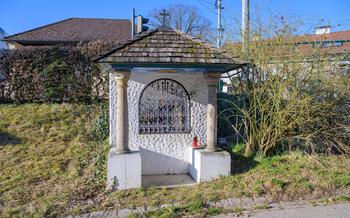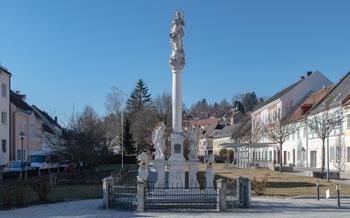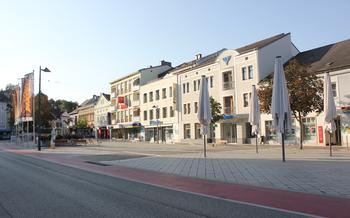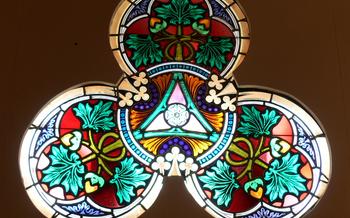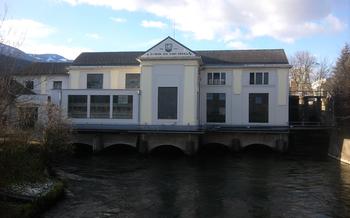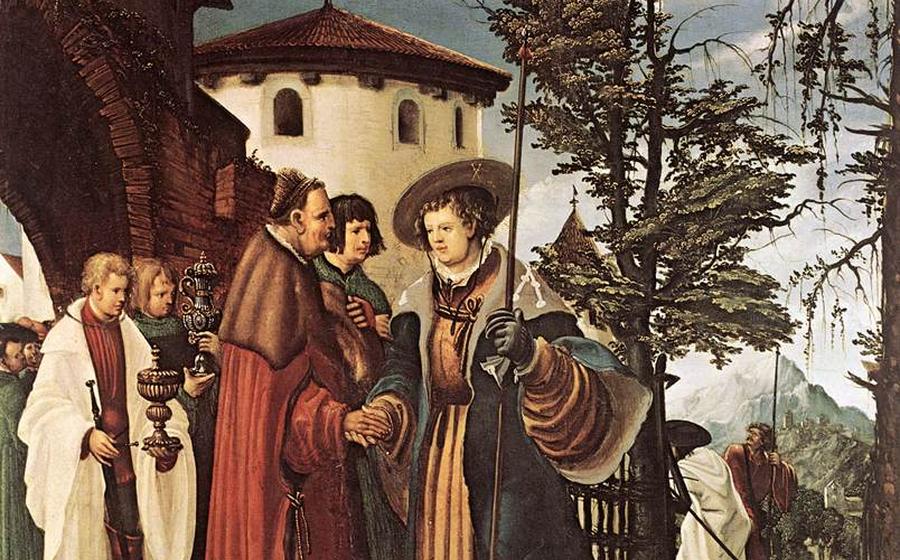
St. Florian Monastery
- Historical Significance
- Architectural Masterpiece
- Sacred Art and Treasures
- Musical Heritage
- Monastery Museum
- Guided Tours
- Pilgrimage Site
- Monastic Life
- Nature and Surroundings
- Events and Festivals
- Café and Restaurant
- Shopping and Souvenirs
- Accessibility and Facilities
- Insider Tip: Unveiling Hidden Treasures and Discovering the Region's Richness
Historical Significance
St. Florian Monastery, a testament to centuries of faith and heritage, stands as one of Austria's oldest abbeys, tracing its roots back to the 11th century. Founded by Augustinian canons, it quickly rose to prominence as a center of religious and cultural life in the Middle Ages. The monastery's scriptorium became renowned for its exquisite manuscripts, contributing to the development of Western calligraphy and illumination. As a leading center of Gregorian chant, St. Florian played a pivotal role in shaping the musical landscape of Europe, influencing composers and musicians for generations to come. Despite facing challenges during wars and periods of secularization, the monastery's resilience shone through, culminating in its restoration in the 19th century, which brought renewed splendor to its sacred halls.
Architectural Masterpiece
St. Florian Monastery stands as a testament to the architectural genius of its builders, showcasing a harmonious blend of Romanesque, Gothic, and Baroque styles. The monastery's grand facade, adorned with intricate carvings and elegant towers, captivates the eye, inviting visitors to step into a world of artistic excellence. The interior of the monastery is equally impressive, with its soaring ceilings, ornate altars, and exquisite frescoes.
The monastery's design is the work of renowned architects, including Carlo Carlone and Jakob Prandtauer, who left an indelible mark on the monastery's appearance. Carlone's influence is evident in the monastery's Baroque façade, with its curved pediments, decorative pilasters, and sweeping staircases. Prandtauer, on the other hand, contributed to the monastery's interior, creating a harmonious blend of Baroque and Gothic elements.
Ongoing restoration efforts are meticulously preserving the monastery's architectural integrity and enhancing its beauty. These efforts include the restoration of the monastery's frescoes, the conservation of its intricate carvings, and the refurbishment of its grand halls. By preserving the monastery's architectural heritage, these efforts ensure that future generations can continue to appreciate its splendor.
Sacred Art and Treasures
St. Florian Monastery is home to a remarkable collection of sacred art and treasures that reflect its rich history and spiritual significance. Among the highlights are stunning paintings by renowned artists such as Martin Johann Schmidt, also known as "Kremser Schmidt," whose works adorn the monastery's walls and ceilings. The high altar, with its intricate carvings and radiant gold leaf, is a masterpiece of Baroque craftsmanship. The stained glass windows depict biblical scenes with vibrant colors and exquisite detail, casting a warm glow into the monastery's interior. The reliquary of St. Florian, a finely crafted silver and gold reliquary, holds the remains of the monastery's patron saint and is a revered object of devotion. These sacred treasures, meticulously preserved and restored, offer visitors a glimpse into the monastery's deep faith and artistic heritage. Ongoing conservation efforts ensure that these precious works of art will continue to inspire and awe generations to come.
Musical Heritage
St. Florian Monastery has a rich musical history that dates back to the Middle Ages and continues to the present day. The monastery's choir school, founded in the 11th century, is one of the oldest and most renowned in Europe. It has played a crucial role in preserving and promoting Gregorian chant and polyphonic music.
Over the centuries, many renowned musicians have been associated with St. Florian Monastery. Anton Bruckner, one of the most influential composers of the Romantic era, served as the monastery's organist from 1855 to 186His time at the monastery profoundly influenced his musical development, and he composed several of his most important works during this period.
Today, St. Florian Monastery continues to be a center of musical excellence. The monastery's choir, consisting of both monks and professional singers, performs regularly in the monastery church and throughout the world. The monastery also hosts concerts, recitals, and workshops, attracting music lovers from around the globe.
In addition to its musical heritage, St. Florian Monastery is also home to a valuable collection of musical instruments, including organs, harpsichords, and violins. These instruments are regularly used in concerts and recordings, ensuring that the monastery's musical legacy continues to live on.
Monastery Museum
St. Florian Monastery houses a fascinating museum that takes visitors on a journey through the monastery's rich history, art, and cultural heritage. The museum's interactive and engaging exhibits bring to life the stories of the monastery's past, from its humble beginnings to its rise as a leading center of religious and cultural life.
The museum's collection includes a diverse array of artifacts, including historical documents, liturgical objects, and everyday items that provide a glimpse into monastic life. Visitors can admire the intricately carved wooden choir stalls, the opulent vestments worn by the monks, and the everyday tools and utensils used in the monastery's kitchens and workshops.
The museum also features a section dedicated to the monastery's musical heritage, showcasing instruments, manuscripts, and other items related to the monastery's renowned choir school and its association with renowned composers such as Anton Bruckner.
Educational programs and workshops are offered by the museum, making it a valuable resource for students and visitors alike. These programs provide an opportunity to learn more about the monastery's history, art, and music, and to engage with the Augustinian Canons who reside at the monastery.
Guided Tours
St. Florian Monastery offers a variety of guided tours that provide visitors with a deeper insight into its history, architecture, and significance. Standard guided tours cover the main highlights of the monastery, including the Baroque church, the library, and the museum. Themed tours focus on specific aspects of the monastery's history or heritage, such as its musical tradition or its role as a pilgrimage site. Special tours are available for groups and can be customized to meet their specific interests.
The tours are led by knowledgeable and enthusiastic guides who share their passion for the monastery with visitors. They bring to life the stories of the monks who lived and worked here, the events that shaped the monastery's history, and the artistic treasures it holds. Visitors can ask questions and engage in discussions with the guides, making the tour a truly interactive and enriching experience.
It is recommended to book tours in advance, especially during peak season, to secure a spot and avoid disappointment. Visitors can book their tours online or by contacting the monastery directly. Guided tours are available in multiple languages, and multilingual staff is available to assist international visitors.
Pilgrimage Site
St. Florian Monastery holds a significant place as a pilgrimage site, attracting devotees from near and far to pay homage to the revered St. Florian. The saint, who met martyrdom during the Roman persecutions, is widely venerated as the patron saint of firefighters and chimney sweeps.
Pilgrims flock to the monastery, drawn by the spiritual aura and the opportunity to seek guidance and healing through the intercession of St. Florian. The monastery serves as a center of devotion, where pilgrims can participate in religious services, light candles, and offer prayers at the saint's shrine.
The annual St. Florian pilgrimage, held on May 4th, is a particularly significant event that draws thousands of pilgrims to the monastery. This grand celebration features a solemn procession, where a statue of St. Florian is carried through the town, accompanied by religious music and prayers. Pilgrims join in the procession, expressing their devotion and seeking blessings from the saint.
Visiting St. Florian Monastery as a pilgrimage site offers a unique opportunity for spiritual reflection and connection with the legacy of St. Florian. Whether seeking solace, guidance, or a deeper understanding of the saint's life, pilgrims will find a welcoming and sacred space within the monastery walls.
Monastic Life
At the heart of St. Florian Monastery lies a vibrant community of Augustinian Canons, who continue to uphold the centuries-old traditions of monastic life. Their daily routine revolves around prayer, work, and community, guided by the Rule of St. Augustine.
Prayer forms the cornerstone of their existence, with the monks gathering for communal prayers several times a day, including the solemn celebration of the Eucharist. In their prayers, they seek to deepen their relationship with God, intercede for the needs of the world, and offer praise and thanksgiving for the blessings received.
Work is an integral part of monastic life, as the monks engage in various tasks to sustain the community and contribute to the common good. They tend to the monastery's gardens and workshops, manage administrative duties, and provide pastoral care to the local community. Their work is not merely a means to an end but a way to glorify God and serve others.
Community is essential to the Augustinian Canons. They live together in a spirit of fraternity, sharing meals, chores, and decision-making. They strive to create a welcoming and supportive environment where each member can grow spiritually and personally. Through their communal life, they embody the values of love, forgiveness, and mutual respect.
Nature and Surroundings
Nestled amidst rolling hills and lush forests, St. Florian Monastery offers visitors a tranquil retreat surrounded by breathtaking natural beauty. The monastery's commitment to sustainability and environmental stewardship is evident in its efforts to reduce its carbon footprint and promote biodiversity. Visitors can immerse themselves in the serene atmosphere of the monastery's surroundings by embarking on leisurely hikes or cycling excursions through the picturesque landscapes. The nearby Enns River invites visitors to enjoy scenic walks along its banks, while the UNESCO World Heritage Site of the Wachau Valley, with its stunning vineyards and charming villages, is just a short drive away. Whether seeking spiritual rejuvenation or simply a relaxing escape into nature, St. Florian Monastery provides a sanctuary for visitors to reconnect with the wonders of the natural world.
Events and Festivals
St. Florian Monastery is not only a place of spiritual reflection and historical significance but also a vibrant hub of cultural activities. Throughout the year, the monastery hosts a variety of events and festivals that offer visitors a chance to experience its unique atmosphere and rich traditions.
One of the highlights of the monastery's calendar is the annual Florianimarkt, a historic market fair held in honor of St. Florian. This traditional event takes place in May and features a colorful array of market stalls selling local crafts, handmade goods, and delicious treats. Visitors can enjoy live music, traditional dancing, and other festive activities while immersing themselves in the lively atmosphere of the fair.
In addition to the Florianimarkt, the monastery hosts a variety of cultural events, such as concerts, exhibitions, and theater performances. These events take place in the monastery's magnificent Baroque halls, providing a stunning backdrop for a truly unforgettable experience. From classical music concerts to contemporary art exhibitions, there is something to suit every taste and interest.
For those seeking a more spiritual experience, the monastery regularly hosts Gregorian chant concerts and organ recitals. These concerts showcase the monastery's rich musical heritage and offer visitors a chance to experience the beauty and power of sacred music in a breathtaking setting.
Before planning your visit, be sure to check the monastery's website for the latest event calendar. This will ensure that you don't miss out on any of the exciting events and festivals that St. Florian Monastery has to offer.
Café and Restaurant
Indulge in culinary delights and soak in the monastery's ambiance at its charming café and restaurant. The café offers a tempting array of Austrian specialties, freshly baked pastries, and refreshing beverages, perfect for a quick bite or a leisurely afternoon break. For a more formal dining experience, the restaurant presents a seasonal menu featuring gourmet dishes inspired by monastic traditions and prepared with fresh, locally sourced ingredients. Savor the flavors of the region while enjoying the unique atmosphere of this historic setting. The proceeds from the café and restaurant directly support the monastery's ongoing restoration and preservation efforts, making your dining experience not only enjoyable but also meaningful.
Shopping and Souvenirs
At St. Florian Monastery, visitors can find a unique and memorable shopping experience in the monastery's gift shop. This charming shop offers a wide range of souvenirs and artisanal products that celebrate the monastery's rich history and cultural heritage. From books and religious items to locally crafted souvenirs, there is something for everyone at the monastery's gift shop.
The selection of books includes a variety of titles on the monastery's history, architecture, art, and music. Visitors can also find a range of religious items, such as rosaries, crucifixes, and statues of St. Florian. For those looking for a unique and meaningful gift, the monastery's gift shop offers a variety of locally crafted souvenirs, such as pottery, glassware, and textiles.
Proceeds from the gift shop directly support the monastery's ongoing restoration and preservation efforts. By purchasing a souvenir from the monastery's gift shop, visitors can not only take home a piece of the monastery's history but also contribute to its future.
Accessibility and Facilities
St. Florian Monastery is committed to providing a welcoming and accessible environment for all visitors. The monastery features wheelchair ramps, elevators, and designated parking spaces to ensure that visitors with disabilities can fully enjoy their experience. The monastery's staff is trained to assist visitors with disabilities and provide any necessary accommodations.
Various facilities are available to enhance visitors' comfort and convenience. Restrooms, a first-aid station, and a cloakroom for storing luggage or backpacks are located throughout the monastery. Guided tours are offered in multiple languages, and multilingual staff is available to assist international visitors.
To make the most of your visit, check the monastery's website for information on guided tours, events, and accessibility features. The website also provides contact information for the monastery's staff, who can assist with any inquiries or special requests.
Insider Tip: Unveiling Hidden Treasures and Discovering the Region's Richness
For an unforgettable experience, venture beyond the main attractions of St. Florian Monastery and explore its hidden gems. Join a guided tour to uncover secret passages, forgotten chambers, and intriguing stories that lie beneath the monastery's grand facade. Immerse yourself in the serene atmosphere of the herb garden, where monks cultivate aromatic plants for medicinal and culinary purposes. Attend a Gregorian chant concert in the monastery church to witness the timeless beauty of this ancient musical tradition.
After exploring the monastery's secrets, take advantage of its ideal location to discover the surrounding region. Stroll through the charming streets of Enns, a medieval town with well-preserved fortifications and a rich history. Embark on a scenic bike ride along the Enns River, enjoying breathtaking views of the countryside. For a deeper dive into the region's cultural heritage, visit the nearby UNESCO World Heritage Site of the Wachau Valley, renowned for its picturesque landscapes, historic abbeys, and world-class wines.
Consider combining your visit to St. Florian Monastery with other attractions in the area. Pay homage to the victims of World War II at the Mauthausen Memorial, explore the modern and contemporary art collection at the Linz Art Museum, or marvel at the architectural splendor of Stift Melk Abbey. The region offers a wealth of experiences, ensuring a memorable and enriching journey.
